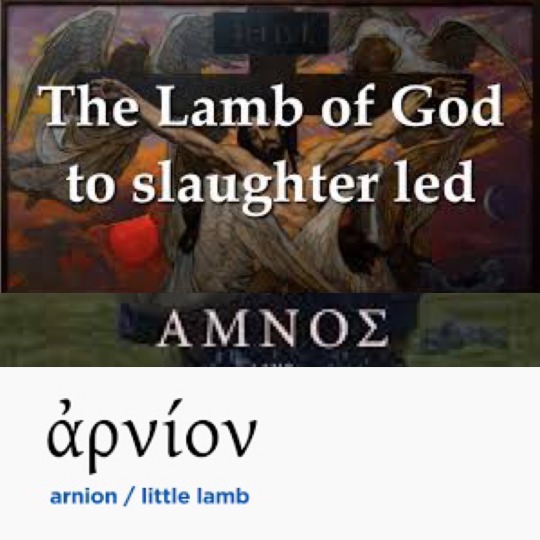#Biblecontradictions
Explore tagged Tumblr posts
Text

🔎 Bible Contradictions: In Using the Term “Arnion,” Does the Book of Revelation Contradict John’s Gospel Which Uses the Word “Amnos” Instead? 🔍
By Award-Winning Goodreads Author and Bible Researcher Eli Kittim 🎓
This short essay is a brief reply to a question that was posed by a member of my “Eli Kittim Theology” group on MeWe.
——-
The member’s name is Marlo Bliss. This was his Question:
The writer of the Book of Revelation used
the term "Lambkin" / ARNI'ON <G721> for
Jesus Christ instead of "lamb" / AMNO'S <>
(lambkins require feeding). He did so 26
times. Why this contradiction to John 1.29
and 1.36?
Thanks for any reply.
*I use the DLT (Dabhar Literal Translation)
software in hebrew, greek, english and
german.*
——-
He’s basically asking the following question: if John’s Gospel uses the Greek term Ἀμνὸς twice to refer to Jesus, then why does the Book of Revelation repeatedly use the word ἀρνίον instead? Isn’t that a deviation from the canonical context? Doesn’t that constitute a Biblical contradiction? The implication is that the Book of Revelation appears to be wrong and contradictory in its terminological usage.
First of all, it is important to establish at the outset that both ἀμνός (amnós) and ἀρνίον (arníon) mean the same thing. These terms are not self-contradictory, but rather interchangeable and complementary. Whereas **ἀμνός** (amnós) has the connotation of a consecrated or sacrificial lamb, especially a one-year old lamb, **ἀρνίον** refers to a “little lamb,” under a year old (Henry George Liddell. Robert Scott. A Greek-English Lexicon. Oxford. Clarendon Press. 1940). According to J. Thayer, the connotation of ἀρνίον (arníon) is that of pure innocence, with virgin-like (gentle) intentions.
Second, John’s Gospel uses both amnós and arníon. It’s true that John chapter 1 and verses 29 & 36 use the term Ἀμνὸς (lamb) to refer to Jesus Christ. But this term occurs only twice. And yet, the exact same gospel of John uses the alternative ἀρνία (lambs) in chapter 21 verse 15—-which is the plural form of the singular term ἀρνίον (lamb)——to refer to the *Christ-like* followers, namely, the saints of God who are becoming like Christ.
Third, the use of the word ἀρνίον (arníon) in a “messianic canonical context” is in fact scriptural, as can be seen, for example, in the Book of Jeremiah. In Jeremiah 11.19, the Septuagint (LXX) uses the Greek term ἀρνίον in an overtly messianic context:
ἐγὼ δὲ ὡς ἀρνίον ἄκακον ἀγόμενον τοῦ
θύεσθαι οὐκ ἔγνων ἐπ᾽ ἐμὲ ἐλογίσαντο
λογισμὸν πονηρὸν λέγοντες δεῦτε καὶ
ἐμβάλωμεν ξύλον εἰς τὸν ἄρτον αὐτοῦ καὶ
ἐκτρίψωμεν αὐτὸν ἀπὸ γῆς ζώντων καὶ τὸ
ὄνομα αὐτοῦ οὐ μὴ μνησθῇ ἔτι.
English translation by L.C.L. Brenton:
But I as an innocent lamb led to the
slaughter, knew not: against me they
devised an evil device, saying, Come and let
us put wood into his bread, and let us
utterly destroy him from off the land of the
living, and let his name not be remembered
any more.
This is reminiscent of Isaiah 53. In fact, Jeremiah’s aforementioned verse is a parallel to——and presents a near-verbal agreement with——Isaiah 53.7 (LXX):
καὶ αὐτὸς διὰ τὸ κεκακῶσθαι οὐκ ἀνοίγει
τὸ στόμα· ὡς πρόβατον ἐπὶ σφαγὴν ἤχθη
καὶ ὡς ἀμνὸς ἐναντίον τοῦ κείροντος αὐτὸν
ἄφωνος οὕτως οὐκ ἀνοίγει τὸ στόμα
αὐτοῦ.
Translation (NRSV):
He was oppressed, and he was afflicted,
yet he did not open his mouth; like a lamb
that is led to the slaughter, and like a sheep
that before its shearers is silent, so he did
not open his mouth.
In Jeremiah 11.19, the L.C.L. Brenton translates ἀρνίον “as an innocent lamb led to the slaughter,” while the NRSV similarly renders it as a “gentle lamb led to the slaughter.” The theological idea in Jeremiah 11.19 is consistent with that of Isaiah 53.7—-which says “like a lamb that is led to the slaughter”——even though Isaiah employs the terms πρόβατον (lamb) and ἀμνὸς (sheep) instead of Jeremiah’s use of the word ἀρνίον (lamb). These thematic parallels demonstrate that the above terms are interchangeable.
Thus, the Septuagint (LXX) uses 3 alternative terms to refer to this so-called messianic “lamb” of God who “was wounded for our transgressions, crushed for our iniquities; … and by his bruises we are healed” (Isaiah 53.5). Two of the three terms that the LXX uses for this *slaughtered messiah* are found in Isaiah 53.7, namely, πρόβατον and ἀμνὸς. Incidentally, πρόβατον (probaton) means ἀρνίον, which comes from ἀρήν (meaning “lamb”). Thus, ἀμνός (amnós), πρόβατον (próbaton), and ἀρνίον (arníon) are essentially interchangeable terms.
The word πρόβατον (probaton), which means ἀρνίον, is also used in Gen 22.8 by the LXX to refer to the sacrificial lamb of God:
Abraham said, ‘God himself will provide the
lamb for a burnt offering, my son.’ (NRSV)
The Septuagint also uses the Greek term πρόβατον (which means ἀρνίον) to refer to the sheep which is slaughtered as a “sin offering” in Lev 4.32.
Therefore, the Book of Revelation uses the exact same term that is found not only within the Biblical canonical-context itself (Jn 21.15), but also within the writings of the Septuagint as well. So how is it contradictory? It is not!
Conclusion
As you can see, the way in which the Koine Greek language has been used in both the Septuagint (LXX) and the New Testament clearly shows that the words ἀμνός (amnós), πρόβατον (próbaton), and ἀρνίον (arníon) are essentially interchangeable and complementary terms. These 3 words have all been used in terms of a “messianic sin offering,” that is, in reference to an innocent lamb that is led to the slaughter (cf. Rev. 5.6 ἀρνίον ἑστηκὸς ὡς ἐσφαγμένον/“a Lamb standing as if it had been slaughtered”). Although these terms have slightly different nuances, nevertheless they have been used consistently within a “messianic scriptural context” across the board. This is based on the principle of expositional constancy, the idea that similar terms and images are used consistently throughout scripture.
Since most scholars don’t think that John’s Gospel and the Book of Revelation were written by the same author, this would explain why they don't use the exact same terminology. Different biblical authors use different vocabularies. This fact alone doesn’t preclude their books from being seen as authoritative or inspired. On the contrary, if we look at the 27 New Testament books, this seems to be the rule rather than the exception!
Thus, Mr. Marlo Bliss’ accusation——that “the writer of the Book of Revelation [who] used the term "Lambkin" / ARNI'ON … for Jesus Christ instead of "lamb" / AMNO'S” was contradicting “John 1.29 and 1.36”——is unwarranted and without merit!
Incidentally, I looked at the so-called “DLT” (Dabhar Literal Translation) that Mr. Bliss uses, but unfortunately it is not faithful to the original Greek New Testament text. Besides, there is no disclosure or commentary about which text-types were used or if there even was a committee of scholars who edited it, which I seriously doubt, given the poor quality of the translation. I’ve also come across some YouTube videos, that are put out by the same sect, which endorse the Dabhar Literal Translation. Unfortunately, this English translation is of an inferior quality. Adherents of this cult further claim that the Book of Revelation is a “spurious” book. This sounds like a sect that has drifted away from sound Bible teaching!
——-
#lamb of god#questions and answers#ἀρνίον#πρόβατον#ἀμνός#agnus dei#Elikittimtheologygroup#mewe.com#book of revelation#gospel of john#LCLBrentontranslation#elikittim#the little book of revelation#ek#lxx#septuagint#old testament#ελικιτίμ#ΕλληνιστικήΚοινή#το μικρό βιβλίο της αποκάλυψης#BiblicalGreek#εκ#NewTestamentGreek#KoineGreek#bible translation#bibleexegesis#HellenisticGreek#Biblecontradictions#christian apologetics#JesusLambOfGod
6 notes
·
View notes
Text
Listening to SaNeterTv Bible contradiction
1 note
·
View note
Photo

TODAY I WILL BE DISCUSSING. DIVINATION IS IN THE BIBLE AND ITS CONTRADICTIONS!! #divination #clubhouseapp #biblecontradictions You can find the link to my clubhouse in the linktree here @living_thatmetalife https://www.instagram.com/p/Ch7hWXKOE34/?igshid=NGJjMDIxMWI=
0 notes
Photo

Another Episode of Blessed Dressed! Link in Bio. Let's go there. What the Bible ACTUALLY says about modesty. If this topic makes you uncomfortable or gives you bubbly guts, you especially ought to watch. You can also search "Blessed Dressed Sis Vic" on YouTube #blesseddressed #cleavagefordays #modestishottest #biblecontradictions #adventistfashion #christianmodel #midrifftop #baptistfashion #highfashion #modestfashion #rccgna #rccgnayasm https://www.instagram.com/p/CaLmsqpuYIW/?utm_medium=tumblr
#blesseddressed#cleavagefordays#modestishottest#biblecontradictions#adventistfashion#christianmodel#midrifftop#baptistfashion#highfashion#modestfashion#rccgna#rccgnayasm
0 notes
Photo

WAS JESUS ONLY FOR THE JEWS?! Read full article here⏩ http://wp.me/p8zSB6-gH @mcgidotorg @mrcontroversyx @al_furqan @de.bate @muslimsoftheworld1 @queeniepadillarevert @iin_qurrotul_ain @allahsword @timeoutisrael #islam #biblecontradictions #bart #montulfo
0 notes
Photo

Truths in the Bible Despite Human Errors | John - San Antonio, TX | Atheist Experience 23.26 http://ehelpdesk.tk/wp-content/uploads/2020/02/logo-header.png [ad_1] The Atheist Experience 23.26 for... #academics #agnostic #agnosticism #atheism #atheismdebate #atheist #atheistdebate #atheistexperience #atheistvschristian #belief #bible #biblecontradictions #calculus #chineselanguage #christianity #datastructures #debate #doubt #englishconversation #englishgrammar #englishlanguage #evidence #evidenceforgod #evidenceforjesus #faith #fallacy #frenchlanguage #germanlanguage #ielts #isgodreal #islam #japaneselanguage #jesus #jesuschrist #linearalgebra #logic #math #mattdillahuntybroadcastartist #morality #probability #proof #questioninggod #rational #reason #religion #religiondebate #religious #science #secular #signlanguage #skeptic #skepticism #spanishlanguage #statistics #teaching #theatheistexperience #thebible #theatheistexperience
0 notes
Photo

(via Bible Contradictions #8 | theUKAtheist)
46 notes
·
View notes
Text

Has Anyone Ever Seen Jesus?
By Bible Researcher Eli Kittim 🎓
—
Jesus Christ, Whom No Human Being Has Ever Seen
Writing at the end of the first century AD, 1 Timothy 6.14-16 (SBLGNT) surprisingly says that Jesus Christ “WILL BE REVEALED” in due time:
τηρῆσαί σε τὴν ἐντολὴν ἄσπιλον
ἀνεπίλημπτον μέχρι τῆς ἐπιφανείας τοῦ
κυρίου ἡμῶν Ἰησοῦ Χριστοῦ, ἣν καιροῖς
ἰδίοις δείξει ὁ μακάριος καὶ μόνος
δυνάστης, ὁ βασιλεὺς τῶν βασιλευόντων
καὶ κύριος τῶν κυριευόντων, ὁ μόνος ἔχων
ἀθανασίαν, φῶς οἰκῶν ἀπρόσιτον, ὃν εἶδεν
οὐδεὶς ἀνθρώπων.
Translation (NJB):
do all that you have been told, with no faults
or failures, until the appearing of our Lord
Jesus Christ, who at the due time will be
revealed by God, the blessed and only Ruler
of all, the King of kings and the Lord of
lords, who alone is immortal, whose home is
in inaccessible light, whom no human being
has seen.
According to Bible scholars, the First Epistle to Timothy was written by an unknown author in Macedonia, Greece at the end of the first century AD. But according to the gospels, the chronology of Jesus’ ministry (which is typically dated to around 27-36 AD) supposedly took place at least 64 years earlier. Yet these two accounts appear to contradict each other. If either one of them is true, the other must be false. However, in my view, both of them are true. We’re just comparing different genres (Theological versus Didactic literature).
About whom is the passage written? The aforementioned passage is clearly talking about the so-called “king of kings and lord of lords,” a title that is uniquely associated with Jesus Christ. In fact, it mentions him by name and says that he will be revealed in due time. That means that he was never previously revealed! It further exhorts believers to do good “until the appearing of our Lord Jesus Christ … whom no human being has seen.”
First Timothy 6.14-16 therefore confirms Heb. 9.26b, 1 Peter 1.20, and Rev. 12.5, among other verses, that Christ’s initial revelation takes place in the end-times!
—
The Son of Man Comes at Some Point in Human History
2 John 1.7 (SBLGNT) reads:
πολλοὶ πλάνοι ἐξῆλθον εἰς τὸν κόσμον,
οἱ μὴ ὁμολογοῦντες Ἰησοῦν Χριστὸν
ἐρχόμενον ἐν σαρκί · οὗτός ἐστιν ὁ πλάνος
καὶ ὁ ἀντίχριστος.
Translation (YLT):
many leading astray did enter into
the world, who are not confessing Jesus
Christ coming in flesh; this one is he who is
leading astray, and the antichrist.
Yet in deference to Biblical usage, I’m not denying John’s proclamation of “Jesus Christ coming in [the] flesh” (2 John 1.7) but rather qualifying it in terms of its chronological relevance. In other words, I deny the *timing* of this event, not the event itself! Put differently, I certainly don’t deny the notion of Jesus Christ as coming in the flesh at some point in human history. I’m simply asking, “WHEN,” according to Scripture.
—
#visibleJesus#therevelationofJesus#son of man#epiphany#jesus christ#endtimes#lastdays#2John1v7#bibleexegesis#Elikittim#1Timothy6v16#gospels_versus_epistles#biblicalchronology#bible commentary#JESUSMYTHICISM#bible study#antichrist#deception#bibletranslations#analogyofscripture#ελικιτίμ#thelittlebookofrevelation#greeknewtestament#το μικρό βιβλίο της αποκάλυψης#εκ#biblecontroversy#ek#bibleprophecy#biblecontradictions#didactic literature
5 notes
·
View notes
Photo

(via Bible Contradictions #7 | theUKAtheist)
15 notes
·
View notes